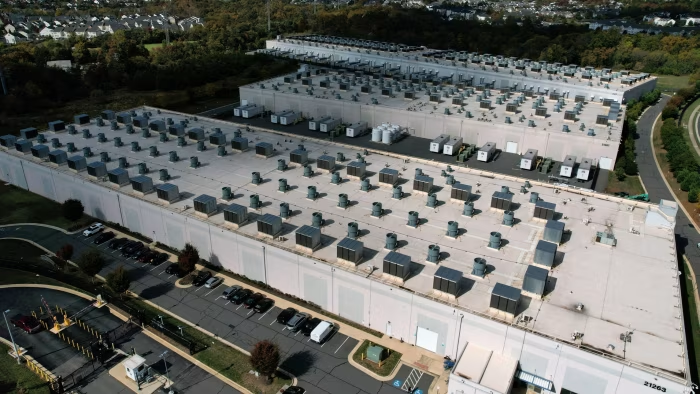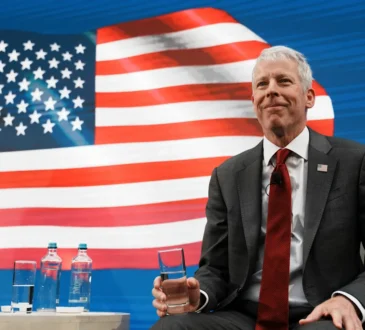
Hello and welcome to Energy Source, coming to you from New York.
US President Donald Trump on Wednesday attempted to downplay his party’s defeat after Democrats won closely watched off-year elections across the country on Tuesday.
Affordability was a top concern among voters, with higher electricity bills being a source of anxiety in New Jersey and Virginia. My colleague Martha Muir reported that the New Jersey governor-elect, Democrat Mikie Sherrill, pledged to declare a “state of emergency” and freeze utility rates on day one of being in office.
Democrat Abigail Spanberger, who won Virginia’s governor race, said in her victory speech that the state would produce more energy and make sure that large utility users paid their “fair share”.
In today’s Energy Source, we dive into an exclusive Rocky Mountain Institute report on virtual power plants and how they could provide energy flexibility to meet data centre energy demand without driving up costs for ordinary Americans. — Alexandra
Could virtual power plants meet data centre demand and lower electricity bills?
Technology companies are investing billions of dollars to build and power data centres across the US, but the industry’s enormous electricity consumption has put pressure on utilities and grid operators that are struggling to quickly meet surging demand.
A new report shared with Energy Source, however, finds that much of this demand could be rapidly met by managing existing resources without triggering higher electricity costs for ordinary Americans.
The Rocky Mountain Institute found that virtual power plants (VPP) — a decentralised network of small energy assets such as solar panels or smart thermostats that are co-ordinated with software — could be utilised by data centres to meet much of their energy needs by shifting demand during peak periods. RMI estimates that VPPs could expand to meet more than 20 per cent of peak US demand in 2030 and reach a market size on par with projected data centre growth.
“If we just shift demand for a few hundred hours rather than building a whole new power plant, we increase the utilisation of the whole power system,” said Jesse Cohen, senior associate at RMI and one of the authors of the report. “That tends to be economically more efficient.”
Instead of waiting years for natural gas plants to be built or to interconnect solar or wind assets to the grid, VPPs are available to help data centres meet demand now. If data centres and other large loads invest directly in VPP programmes, that could insulate households and small businesses from higher electricity prices.
RMI said there were ways for data centre operators to directly invest in VPPs and suggested three different methods for them to assume the cost.
The first model would require the utility to procure the VPP on behalf of the hyperscaler, allowing the data centre to take on the cost rather than passing it on to households and small businesses.
In the second model, the data centre would directly fund a third-party VPP, which could include investing in home batteries or smart thermostats in households in order to leverage that resource during times of peak demand. The utility or grid operator would certify the capacity of the VPP to bring on new load.
Voltus, a VPP operator, already works under this model in its “bring your own power” product that it launched this year, which allows data centres to fund flexibility and grid reliability that could also benefit its neighbours.
Cloverleaf Infrastructure, a company that develops clean-powered and ready-to-build sites for data centres, is working with Voltus and exploring utilising VPPs across multiple sites it is developing in the US.
“The general misconception is that people look at a data centre and [assume] it is using power 24/7 . . . I don’t think that’s true,” said Brian Janous, Cloverleaf co-founder and chief commercial officer. “The grid is underutilised most of the time. If we can get more [flexible] resources, we can get more data centres connected.”
Janous added that VPPs could also help data centre operators avoid capital-intensive projects, providing a hedge against the uncertainty of how much energy demand is actually going to materialise.
The last model that RMI has proposed is one in which a utility or grid operator enters into a flexible interconnection agreement with a data centre that has invested in a VPP. For example, if the utility calls on a data centre to reduce its load, it could get the VPP to decrease demand in nearby areas, allowing the utility and data centre more grid flexibility.
As the industry navigates how best to adopt VPPs, data centre operators remain interested in the potential of these systems to meet their energy needs.
James Johnston, chief executive of Piclo — a marketplace platform that connects utilities and grid operators with VPP providers and other distributed energy resources — said data centres had supercharged demand for his business as many are seeking flexibility resources.
“The sector is in crisis right now. There is no way to deliver the power requirements using traditional methods,” Johnson said. “The smaller scale the asset, the faster and lower cost it is to deploy . . . what’s happening now is the realisation that there is no real alternative other than relying on [flexibility].” (Alexandra White)
Job moves
-
Golden State Mining appointed Keith Middleton as chief executive and managing director.
-
Galilee Energy named Joseph Graham as chief executive.
-
Elixir Energy appointed Justin Ferravant as chief financial officer.
-
Energy World Corporation named Joseph Meyer as chief financial officer.
Power Points
-
Australia has launched a plan to force energy companies to offer free electricity to households during the day, in a bid to rebalance the grid away from coal and gas by utilising excess solar capacity.
-
Danish wind turbine maker Vestas announced a share buyback and improved profit, with chief executive Rasmus Errboe noting that costs were starting to level off.
-
The threat of retribution from the Trump administration is hanging over the COP30 climate summit in Brazil, with delegates fearing that US officials could pressure other countries to quit the Paris climate agreement.
Energy Source is written and edited by Jamie Smyth, Martha Muir, Alexandra White, Tom Wilson, Rachel Millard and Malcolm Moore, with support from the FT’s global team of reporters. Reach us at energy.source@ft.com and follow us on X at @FTEnergy. Catch up on past editions of the newsletter here.
Recommended newsletters for you
Moral Money — Our unmissable newsletter on socially responsible business, sustainable finance and more. Sign up here
The Climate Graphic: Explained — Understanding the most important climate data of the week. Sign up here



